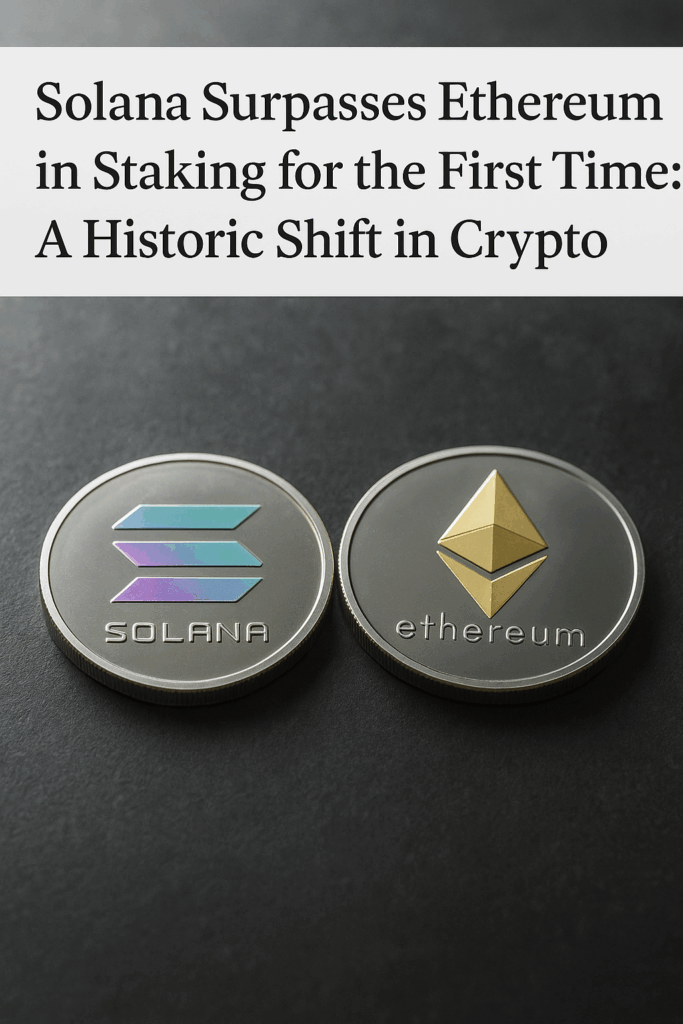For the first time in crypto history, Solana (SOL) has overtaken Ethereum (ETH) in staking — a metric long considered a bellwether of blockchain network security, user confidence, and investor conviction. More coins are now locked on Solana than Ethereum, staking rewards are higher, and momentum across the Solana ecosystem has positioned it as the new leader in proof-of-stake dominance.
What Just Happened?
Until now, Ethereum was widely viewed as the undisputed leader in staking, thanks to its early transition from proof-of-work to proof-of-stake in 2022 (via the Merge). But the tables have turned.
- Staking Volume: Roughly 410–420 million SOL are currently staked, representing nearly 67–70% of Solana’s circulating supply. In dollar terms, that’s about $67–70 billion locked.
- Ethereum Comparison: Ethereum, by contrast, has around 28–30% of its supply staked, totaling $65–68 billion in value. This means Solana now leads not only in staking participation but also in overall staked market capitalization.
- Reward Rates: Solana staking offers annual yields between 8.3% and 11.5%, depending on validator choice and platforms like Jito, which share MEV (maximal extractable value) rewards with stakers. Ethereum’s staking APY is significantly lower, typically 2.9%–3%.
This combination of higher rewards and broader participation has tilted the balance firmly in Solana’s favor.
Why Is Solana Winning the Staking Game?
- Accessibility and Lower Barriers
On Solana, anyone can stake without a minimum requirement. By contrast, Ethereum requires a minimum of 32 ETH to stake directly — a barrier of more than $110,000 at today’s prices. While liquid staking protocols (like Lido and Rocket Pool) lower this hurdle, they introduce third-party risk and still limit mass participation. - Higher Returns Drive Interest
In the current yield-hungry environment, Solana’s 8–11% APY is a magnet for both retail and institutional investors. This is a stark contrast to Ethereum’s 3% average yield, which feels increasingly unattractive as capital chases efficiency. - Ecosystem Momentum
Beyond staking, Solana’s broader ecosystem is booming:- $11.5 billion+ TVL (total value locked) in DeFi protocols
- $12 billion+ in open derivatives interest
- Record-breaking transaction throughput, often exceeding 100 million transactions per day
This growth reinforces confidence, making staking SOL not just profitable but also a bet on a rapidly expanding ecosystem.
- Network Reliability Improvements
In earlier years, Solana faced criticism for frequent outages and instability. But since mid-2024, network upgrades have drastically improved uptime and reliability. This technological maturity is another factor driving staking adoption.
What About Ethereum?
Ethereum is still the backbone of decentralized finance (DeFi) and remains the home of NFTs, Layer-2 scaling networks, and countless smart contracts. Its staking participation rate is lower (around 28–30%), but its approach prioritizes:
- Security and Decentralization: A large validator set (over 1.3 million validators) ensures Ethereum remains the most decentralized proof-of-stake network.
- Institutional Comfort: Big investors view Ethereum as the more “regulatory-friendly” chain, given its longer track record and ecosystem depth.
- Liquidity: ETH is still the most liquid crypto asset after Bitcoin, with deep institutional and retail markets.
In other words, Ethereum is playing the long game. Its lower staking APY reflects a more conservative, secure, and sustainable model, rather than chasing short-term yield.

Market Implications
- Investor Behavior Shifting
Investors are voting with their coins: higher yields and ease of staking are driving capital toward Solana. This could lead to further SOL price support if the trend continues. - Ethereum Faces Yield Pressure
Ethereum’s staking model may come under renewed scrutiny. Calls for better MEV distribution, validator efficiency, and reduced staking barriers could grow louder. - Competition in DeFi & NFTs
While Ethereum remains dominant in DeFi and NFTs, Solana is rapidly gaining ground, particularly in gaming, decentralized social apps, and low-cost DeFi services. - Institutional Adoption Broadens
Institutional investors — traditionally more ETH-leaning — are now considering Solana allocations as staking yields and network metrics demonstrate its viability.
A Turning Point for Proof-of-Stake
The “flippening” in staking may not mean Solana will overtake Ethereum in overall market cap anytime soon, but it signals a changing narrative in blockchain competition:
- Solana is now seen as the network of efficiency, speed, and yield.
- Ethereum remains the network of resilience, security, and ecosystem depth.
For investors, developers, and institutions, the choice may increasingly depend on whether they prioritize high returns and performance (Solana) or stability and scale (Ethereum).
Final Thought
Solana’s rise above Ethereum in staking is more than a statistical milestone — it’s a reflection of crypto’s evolving priorities. In an era where yield, accessibility, and momentum drive adoption, Solana has positioned itself as the front-runner. Ethereum still commands unmatched ecosystem depth, but Solana’s surge shows that in the world of proof-of-stake, the battle for leadership is far from settled.











